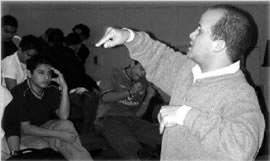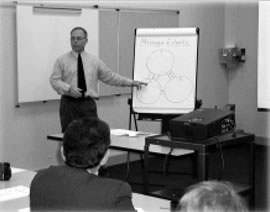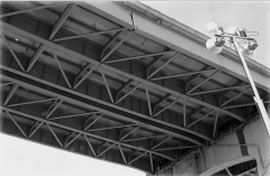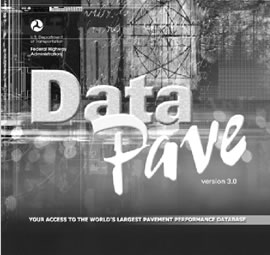U.S. Department of Transportation
Federal Highway Administration
1200 New Jersey Avenue, SE
Washington, DC 20590
202-366-4000
Federal Highway Administration Research and Technology
Coordinating, Developing, and Delivering Highway Transportation Innovations
|
Research & Technology Transporter This newsletter is an archived publication and may contain dated technical, contact, and link information. |
|
| Publication Number: N/A Date: November/December 2001 |
Publication Date: November/December 2001
|
 |
| In celebration of Hispanic Heritage Month, Felipe Luyanda-Andino speaks to Cardozo High School students about the opportunities awaiting them in the transportation field |
As part of Hispanic Heritage Month, Felipe Luyanda-Andino, a highway research engineer at the Federal Highway Administration's (FHWA) Turner-Fairbank Highway Research Center (TFHRC), paid a visit to the students at Cardozo High School in downtown Washington, DC on Oct. 15. His purpose? To encourage young Hispanics and other minorities to consider careers in the transportation field.
Luyanda-Andino visited Cardozo as part of a program sponsored jointly by the FHWA and the Department of Transportation's (DOT) Research and Special Programs Administration (RSPA) celebrating Hispanic Heritage Month. This year's national theme for Hispanic Heritage Month, "Paving the Way for Future Generations," lent itself well to Luyanda-Andino's visit as he educated students about the way transportation affects their lives and discussed potential career opportunities. Fluent in both English and Spanish, Luyanda-Andino gave two presentations-one in English and one in Spanish-at Cardozo, a school with a multi-cultural background.
Inquisitive Cardozo students eager to learn more about transportation quizzed Luyanda-Andino on a number of transportation issues, from gas prices to driver's education courses to roadway construction issues to traffic modeling.
Luyanda-Andino also provided students with information about the Summer Transportation Institute, a program open to high school sophomores and juniors throughout the country. The program, which runs four to six weeks, is jointly coordinated by the DOT and universities across the country and provides participants with in-depth tours of transportation facilities and information on various aspects of transportation and how it affects their daily lives. The program is designed to encourage young people to consider careers in transportation.
Felipe Luyanda-Andino 202-493-3368 Felipe.Luyana-Andino@fhwa.dot.gov
Promoting Federal Highway Administration (FHWA) programs and activities needs people with well-developed communications skills to engage the media. Recognizing the need to nurture those skills in their own staff, the Planning and Environment Core Business Unit (CBU) and the Research, Development, and Technology Service Business Unit (SBU) in the Washington, DC area engaged Steve Moler, Western Resource Center public affairs specialist, to teach a media training course. This full-day course, tailored to meet FHWA needs, teaches communications techniques for use in interviews and other public outreach events.
 |
| Steve Moler, Western Resource Center public afairs specialist, instructs a class in effective media relations to keep the public better informed about FHWA. |
Moler stressed that successful media relations keeps the public better informed about what FHWA does. Using appropriate media techniques helps FHWA stay "on message" and maintain a positive agency image. Course exercises taught participants to prepare for both planned and spontaneous interviews by developing main message points from which to generate sound bites and quotes, a strategy that focuses and controls the interview process to better handle challenges from reporters.
Participants road-tested their skills in mock interviews that were critiqued by other participants. While these lessons were specifically designed for speeches and media interviews, the techniques learned in these mock interviews would enhance any speaker's ability to communicate, no matter what the situation.
Carin Michel of FHWA's Eastern Resource Center created both the training course and its accompanying manual, which serves as media training guidelines for FHWA. Michel and Moler have taught this course in the field and at headquarters. Queries about the course or requests to schedule a training session can be directed to Carin Michel at (410) 962-2530 or via e-mail at carin.michel@fhwa.dot.gov.
Martha M. Soneira (202) 493-3468 martha.soneira@fhwa.dot.gov
Recently, representatives from several transportation agencies and stakeholders in the New York metropolitan area gathered to investigate the potential for an innovative pricing strategy developed by the Federal Highway Administration (FHWA) to manage demand on the region's roadways. The strategy, called "FAIR lanes," or "Fast and Intertwined Regular" lanes, seeks to alleviate public concerns about conversion of currently free lanes to value-priced lanes.
FAIR lanes involve separating congested freeway lanes into two sections-Fast lanes and Regular lanes-using plastic pylons and striping. The Fast lanes would provide improved transit using new "para-transit" and limousine-type services, and would be electronically tolled, with tolls set in real time to limit traffic to the free-flowing maximum. Motorists are advised of the toll rate changes through electronic message boards located in advance of the entry points to the Fast lanes. In the Regular lanes, constricted flow would continue; however, drivers with electronic toll tags would be compensated with credits. Credits could be used as toll payments on days when they choose to use the Fast lanes or as payment for transit and para-transit services, which would be subsidized using toll revenues. The credits would compensate motorists for giving up their right to free use of the lanes converted to Fast lanes.
 |
| FAIR lanes forum participants discussed operational issues, using as an example a 48-km (30-mi) section of the I-287 freeway, which has three lanes in each direction and an additional reversible lane in the middle section of the Tappan Zee Bridge, spanning NewYork's Hudson River. |
New York is discussing this innovative pricing concept because FAIR lanes would carry many more commuters on the existing highway infrastructure during rush hours, improving the ability of its transportation system to accommodate job and economic growth. Commuters would have increased choices and the region would have a new source of revenue to subsidize improved transit and para-transit services and ridesharing programs. And there would also be the potential for significant reductions in overall delay, pollutant and greenhouse gas emissions, and energy consumption.
FAIR lanes could provide an equitable, financially feasible, and economically efficient strategy to meet the transportation needs of the New York metropolitan area. The fact that many vehicles in the New York area are already equipped with electronic transponders may be a plus toward making the concept feasible. Many existing freeways and free bridges were suggested as possible candidates for an immediate demonstration of the concept. It was also suggested that, in the longer term, the region could use the concept to manage new capacity that is proposed for existing freeways.
Participants discussed possible public reaction based on the reaction of solo-driver focus groups held prior to the symposium. The focus groups liked the concept primarily because of the variety of commuting choices that they would have. They did not seem concerned about an existing lane being taken away from them for conversion to a Fast lane. Forum participants agreed, however, that overcoming political and public resistance to new tolls would not be easy.
The forum was co-sponsored by the Eno Transportation Foundation, the New York Metropolitan Transportation Council, and FHWA. The Eno Transportation Foundation is preparing a report on the forum for FHWA. For more information, contact:
Patrick DeCorla-Souza(202) 366-4076 patrick.decorla-souza@fhwa.dot.gov
On December 13, 2000, the Hoan Bridge, which carries I-794 over the Milwaukee River, failed, causing immediate closure of the interstate highway. The forensic evaluation team, led by the Federal Highway Administration's (FHWA) Office of Infrastructure Research & Development (R&D), included personnel from the Wisconsin Department of Transportation (WisDOT), Lichtenstein Engineers, Lehigh University, and Northwestern University. The team determined that the bridge failure was caused by a brittle fracture in the girder webs where the lateral bracing system was connected. Normally, this type of failure can only occur when fatigue damage exists and the material toughness is not sufficient to prevent fracture initiation. However, these factors were ruled out early in the investigation. Extensive material properties testing at the FHWA Structures Laboratory showed that the material properties were good, while an electron microscope examination of the failure at Lehigh University showed no evidence of fatigue.
The reason for the failure became apparent following a detailed three-dimensional nonlinear stress analysis that was performed by FHWA researchers. The results indicated that the particular detail geometry present in the Hoan Bridge created an unusual triaxially constrained stress state that made the bridge particularly susceptible to fracture. In fact, this finding represented a new failure mode for steel bridges that had never been previously documented. Once the problem was identified, the forensic team then designed a retrofit to modify all the vulnerabilities and restore the bridge to full service. The total cost of the Hoan Bridge retrofit was about $7million, compared to an estimated cost of $40 million to replace the bridge entirely.
 |
| The underside of the Hoan Bridge in Milwaukee, where brittle fractures in the girder web forced the closure of the bridge. FHWA researchers identified the cause of the fractures and designed a retrofit to repair them. |
Early in the investigation of the Hoan Bridge failure, FHWA's Office of Bridge Technology tried to determine whether other bridges were vulnerable to similar types of failure. Several hundred bridges were identified as being of the same general type and having the same design features as the Hoan. Fortunately, research is demonstrating that most of these bridges are not vulnerable to constraint-induced fracture. FHWA has issued a technical memorandum to all 50 States that offers some guidance in identifying potential problems in these structures. In fact, a bridge on I-64 in East St. Louis was identified as being another potential case of constraint-induced fracture. This structure is currently being retrofitted to eliminate any chance of failure during the coming winter. FHWA continues to research the problem and to help States identify bridges that may be facing this problem.
The Hoan Bridge Investigation Team was an effective partnership among FHWA, WisDOT, and several universities and consultants. The team cooperated to rapidly restore the Hoan Bridge to service and to identify any other potential safety concerns for other bridges. Their cooperative efforts have resulted in several awards, including the Secretary of the U.S. Department of Transportation's "Thanks a Million" award and the Federal Highway Administrator's "Strive for Excellence" team award.
Ben Tang (202) 366-4592 benjamin.tang@fhwa.dot.gov
Bill Wright (202) 493-3053 bill.wright@fhwa.dot.gov
 |
DataPave 3.0, a software program that provides quick and easy access to most of the data from the Federal Highway Administration's (FHWA) Long Term Pavement Performance (LTPP) program, is now available.
Why is accessing data from the LTPP program so important? The program, which began in 1987, has collected data from more than 2,500 test sections located at 932 sites on in-service highways throughout the United States and Canada in order to provide inventory, material testing, pavement performance monitoring, climatic, traffic, maintenance, rehabilitation, and seasonal data. These data can be analyzed to aid pavement design, construction, maintenance, and rehabilitation.
The latest version of DataPave provides desktop access to most of the LTPP data collected between 1987 and May 2001. In addition to providing more up-to-date data than the previous products, improvements in the 3.0 version include the enhancement of data selection filters, the addition of notes to the graphs to distinguish raw data from computed data, and the improvement of the program's ability to extract site-specific records.
The power of DataPave lies in the fact that LTPP data are readily available to the entirehighway community. Since analysis efforts can be tailored to local or regional sites, highway agencies can develop cost-effective pavement strategies to address their own unique requirements. The research and product development made possible by the LTPP database-and DataPave-will benefit everyone with a stake in the design, construction, maintenance, and rehabilitation of the world's highways.
For more information about DataPave and LTPP, or to obtain your own copy of DataPave, visit the LTPP homepage at www.tfhrc.gov/ltpp.htm or contact the LTPP Customer Service desk at (865) 481-2967 or via e-mail at ltppinfo@fhwa.dot.gov.
Barbara Braswell (202) 366-8027 barbara.braswell@fhwa.dot.gov
Well-coordinated traffic signals can make or break a morning commute. Though perfect signal coordination isn't easy to accomplish, a new product called the Controller Interface Device II (CID II) will help traffic engineers move closer to that ideal. The CID II is the result of a unique collaboration among the Federal Highway Administration (FHWA), the University of Idaho, and private industry.
Traffic engineers use computer software to develop and test signal-timing plans; however, before plans can be implemented in the field, they must be fine-tuned in an actual traffic controller, one operating under actual intersection conditions. Such testing in the field can disrupt traffic and even create unsafe conditions.
 |
| The Controller Interface Device (CID) allows engineers to test traffic-timing plans in the office rather than in the field. |
In the mid-1990s, FHWA Research Development & Technology (RD&T) collaborated with Darcy Bullock, now of Purdue University, to develop a solution-the CID. The CID provided a link between FHWA's CORSIM traffic simulation software and an actual traffic controller, so engineers could test timing plans in the office rather than in the field. Though the original CID prototype was very useful, it was hardwired, bulky, and not suitable for mass production.
In 1998, the University of Idaho received a grant through the Department of Transportation's (DOT) University Transportation Centers (UTC) program. The University of Idaho's National Institute for Advanced Transportation Technology (NIATT) approached FHWA RD&T and proposed a partnership that would address Federal priorities under the UTC program. FHWA asked NIATT to re-engineer the CID for production, and the CID II is the result of that partnership.
The university assembled a diverse team of 23 civil, mechanical, computer science, and electrical engineering students for the effort. Within 2 years, working closely with private industry, university, and government advisors, the team had developed a newly engineered device that was ready for manufacture. The CID II and accompanying software have been licensed to McCain Traffic Supply, and McCain expects to have a commercial CID ready for market in January 2002.
The CID project has proven to be not only a highly successful collaboration among government, education, and industry, it has also given the students who worked on the project the benefit of hands-on, real-world engineering experience.
Raj S. Ghaman, P.E. (202) 493-3270 raj.ghaman@fhwa.dot.gov
In all but a few high-visibility freeway construction and refurbishment projects, the "soft cost" of traveler delay is typically not considered when key decisions about project staging and duration are made. Transportation professionals need user-friendly computer software tools to assist them with decision making for work-zone design and phasing.
Enter QuickZone. QuickZone is an easy-to-use, easy-to-learn traffic analysis delay estimation tool designed to aid State and local design and construction staff, operations and planning staff, construction contractors and even utility contractors. This Microsoft Excel spreadsheet tool can be used to analyze both urban and inter-urban corridors.
QuickZone performs a number of valuable functions of use to traffic professionals in virtually every part of thecountry. It can quantify corridor delay resulting from capacity decreases in work zones; it can identify the impact on delay of alternative construction phasing plans; and it supports trade-off analyses between construction costs and delay costs.
QuickZone also considers alternate phasing schedules, such as location, time-of-day, and season. It can assess the impact of delay-mitigation strategies, such as alternate routing, signal retiming, lane widening, and ramp metering. QuickZone even supports calculation of work-completion incentives.
The software is the first of four products that will eventually make up the Federal Highway Administration's (FHWA) Strategic Work Zone Analysis Tools (SWAT) project, which will also include an Expert System software program, a Cost/Alternative Analysis spreadsheet, and a Detailed Simulation model. Check out the active Partnership Program that offers access to the software's source code for customizing the program to meet local needs.
QuickZone 1.0 will soon be available. QuickZone Beta version 0.99 is available as a free download at http://ops.fhwa.dot.gov/wz/workzone.htm.
Deborah Curtis (202) 493-3267 deborah.curtis@fhwa.dot.gov
Recently, both the Michigan and Missouri departments of transportation (DOTs) became interested in learning how other States were effectively marketing and implementing the results of research projects and promoting research within their State DOTs. Specifically, these two DOTs wanted to identify and learn the best practices of other DOTs and understand how to better implement "things that work."
Under the auspices of the Federal Highway Administration (FHWA), a team was formed and supported with funding from the FHWA Midwest Resource Center Technology Deployment and Marketing Program. The Michigan Department of Transportation (MDOT) and the Missouri Department of Transportation (MoDOT), along with FHWA offices in these States and Michigan Technological University (MTU), forged a strategy to go about this effort.
After determining that DOT out-reach programs similar in size to the Michigan and Missouri programs would be studied, the team decided that Arkansas, Connecticut, Louisiana, North Carolina, and Virginia would be selected as States to be analyzed for their best practices. They began collecting information about the outreach efforts of these State DOTs, first by submitting questionnaires to all the selected States, and then by visiting the five State DOTs to exchange information and to better understand their research programs. A report is being prepared to high-light the common themes and the best practices identified in this review. Already, certain preliminary findings are becoming clear. The team found that:
For more information, contact:
Frederick P. Orloski (517) 702-1840 fred.orloski.@fhwa.dot.gov